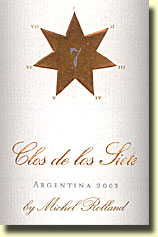
|
|
by Putnam Weekley This is a commercial-free site, yet I work in a wine shop. How independent can I be?
In fact, commercialism permeates all aspects of wine commentary. Real journalists may actually have a tougher time establishing independence than the lowly liquor-store blogger. After all, writers need access, and critical voices may not always be invited back.
I will always be invited to taste a wine of aspiration. A half-case order for the shelf is incentive enough for most purveyors.
I obey one simple rule in both buying and commentary. Can I, or can any of my friends, find any relative merit in a given product, with emphasis on first-hand tasting and re-tasting. A good, original story helps too.
For example, I shouldn't proclaim the merits of Clos de los Siete in a public forum without some assurance that I will receive all 1200 bottles that have been promised to me.
Such an act would be a violation of the Wine Secrecy Code - one that many retailers and restaurants believe in and adhere to.
There is only thing worse than a hovering wine shop staffer: a tight-lipped one.
"What's in the stash? What are you hiding in
back?" I hear it every day.
Fortunately, when pursuit brings me to the crease in the taste envelope, there seem to be open vistas of good stuff, with good stories, and for cheap.
Yet advertising a find on GangOfPour.com can only increase competition and thereby increase the chances my store will either have to pay more for it or get cut from the allocation.
But it's not like Clos de los Siete is a secret. The press has been anticipating important things from this property since it was announced, before the first vine had even been planted. Now Clos de los Siete is ramping up to produce nearly 4 million bottles annually.
And then again, there is the editorial imperative not to endorse a product that can be criticized - even eventually. I am reminded of auspicious debut appearances in the 1990s of wines like Condado de Haza and Estancia Meritage - both under $20 and thrilling. Both were followed by ever-more mediocre and ever-more expensive editions.
I will forever be haunted by the ghosts of brands that I once pushed, having believed them to be excellent and having believed that they might remain excellent (Veuve-Clicquot NV Brut, Phelps Cab, Quintessa, etc.)
Perhaps when all 720 hectares of Clos de los Siete are on line and producing 40 hL/hA, or 320,000 cases (Now only 83,333 cases apparently) I'll regret that I was so enthusiastic. Surely we'll be knee-deep in this stuff. My hunch is that Clos de los Siete will never be as good as its 2003 edition.
Creeping international demand will almost certainly drive the price up closer to $30, even in a glut of gluts. That's how good it is now. What's more, the seven individual partners retain the option of bottling individual estate wines. These they will sell at a premium. What happens when one of these gets splashed on the cover of an in-flight magazine? (Thanks to Neal Martin for this logical point.)
What happens when this
wine gets splashed on the cover of an
No - announcing my admiration for a single bottling of wine, in front of my peers on the GangOfPour.com, is a risk.
But it can not be denied. Clos de Los Siete, by Michel Rolland 2003 Mendoza (a blend of two parts Malbec to one each Cabernet Sauvignon, Merlot and Syrah) is the most shocking value in mouth-purpling red wine since Concannon 2001 Petite Sirah back in February of 2004. It probably exceeds that one for value -primarily due to the fact that it has more in the way of elite styling.
This concentrated Bordeaux blend, made by the pope of Bordeaux, Michel Rolland, reeks of French oak and gooey globs of black berries - "quality" in other words.
The vineyards are pesticide free according to the home page, and though there is some high-quality, chocolaty French oak employed in the cellar, the tannins are mostly from thick-skinned fruit.
About a year ago I was tipped off to the 2003 vintage in Argentina. I took it lightly, but remembered it. This may be final proof of the Argentina/2003 phenomenon.
The vines of Clos de los Siete are now scarcely 4 years old. As they age, they will be asked to crop even heavier. Investors will attempt to squeeze the brand by depleting it with high-ranking, scarce-enough top-bottlings that effectively lower the quality pool for this label.
It's practically guaranteed that this wine will never be as good as it is now.
It will age interestingly for at least five years, and probably for more than ten.
Neal Martin gives it 19 points and calls it a superb value.
I give it 879 points and call it an "atomic" value.
Previously in Putnam's Monthly: Putnam Weekley's Home Page and Main Index © Putnam Weekley 2005 |
|
|

 It's
true. Commercial considerations may occasionally pinch my
side of the conversation. One main concern is always
availability. It would be foolish to rave openly about an
obscure wine that is not for sale anywhere anymore.
It's
true. Commercial considerations may occasionally pinch my
side of the conversation. One main concern is always
availability. It would be foolish to rave openly about an
obscure wine that is not for sale anywhere anymore.